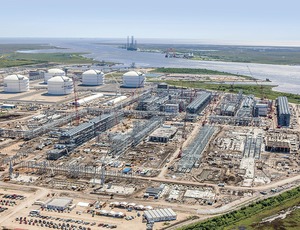

The U.S. shale revolution has spurred construction of many types—remote-site roads, natural-gas processing plants, pipelines, storage-tank farms and petrochemical projects, among them—but few, if any, projects are as challenging to develop, permit, finance and build as the multibillion-dollar plans to liquefy natural gas and load the resulting LNG for shipment overseas.
In late October, construction began on the second of more than a dozen proposed liquefied-natural-gas export terminals. When its three gas-liquefaction "trains" are completed and begin commercial operation in 2018, the $10-billion Cameron LNG facility in Hackberry, La., will be capable of super-cooling about 1.7 billion cu ft of natural gas a day into LNG, a dense, energy-packed liquid that—after shipment to Japanese and other buyers—will be re-gasified for use by electric utilities and other natural-gas consumers.
Cameron LNG, which is being developed by a joint venture of Sempra Energy, GDF Suez, Mitsui & Co. and Mitsubishi Corp., follows Cheniere Energy's Sabine Pass LNG export terminal in Cameron Parish, La., which has been under construction for more than two years and whose first LNG train is expected to begin liquefying gas by early 2016. Three additional trains will follow later, in 2016 and in 2017.
Two other LNG export projects—Freeport LNG in Freeport, Texas, and Dominion Resources' Cove Point LNG in Cove Point, Md.—also have all their regulatory approvals in hand, as well as their long-term LNG off-take agreements, and may well be under construction soon. But the developers of several other projects still are seeking approval for their plans from the Dept. of Energy, the Federal Energy Regulatory Commission or both agencies, and are working to line up deals with overseas utilities to buy large volumes of LNG for 20 to 25 years.
Most of the projects awaiting final federal approvals are located along the U.S. Gulf Coast, but a handful would be built along the West Coast or East Coast.
This "second pack" of LNG export projects faces increasing pressure from U.S. utilities, petrochemical companies and others that argue that exporting too much natural gas overseas will force domestic gas prices higher and undermine the potential for an industrial resurgence here at home.
America's Energy Advantage, an industry group that includes several large consumers of natural gas, has been pressing Congress to reject legislation such as H.R. 6, which was approved by the House of Representatives in June, to streamline the LNG export approval process.
The group said in a September letter to House Speaker John Boehner, "The benefits of America's natural-gas abundance to our domestic economy— robust job creation, manufacturing investment, affordable consumer prices and lower utility bills—are in the public interest of all Americans, and the export volume of this valuable national resource should be considered in that light."
How many projected U.S. LNG facilities will proceed to construction starts in the next two or three years? "I expect seven or eight projects to be built," says Javier Diaz, a senior energy analyst at Bentek Energy who tracks the LNG market.
"Our base-case scenario includes Sabine Pass, Cameron, Freeport, Cove Point" and three other projects: the Lake Charles LNG project in Louisiana, the Elba Island LNG project in Georgia and the Corpus Christi LNG project in Texas, according to Diaz. "The first four have been able to secure both DOE and FERC approvals." Lake Charles and Elba Island have off-take agreements for most of their output "and also are existing LNG import facilities."
The Corpus Christi project, meanwhile, "is well advanced with its FERC application" and has off-take deals in hand for 100% of its first two trains, Diaz says. "We may soon add Jordan Cove LNG [in Oregon], which has approvals from FERC and Canada's National Energy Board to export both U.S. and Canadian gas and is also well advanced in the FERC process."
Paul Patterson, energy analyst at Glenrock Associates of New York City, says, "In the near term, the number of LNG export facilities developed will be largely determined by how many projects can receive the necessary regulatory approvals."
However, he adds, "Over the long term, I think a big driver will be how much competition North American suppliers might encounter from increased overseas supplies. This is a dynamic market, and many things could happen in places [such as] Russia, Qatar and Mozambique," each of which would like to expand LNG exports.
The facilities needed to liquefy natural gas, store the resulting LNG and load it onto ships are complex, expensive and challenging to build. The process begins by treating the pipeline-delivered natural gas, which involves removing natural-gas liquids, water and other impurities that could freeze during the subsequent compressing and refrigeration stages.
As their names suggest, the compression and refrigeration stages pressurize and super-cool the natural gas to less than -260° F—the boiling point for methane, which is the purified form of natural gas— at atmospheric pressure. The compressed LNG, reduced to approximately 1/600 of its natural- state volume, then is stored in tanks to prepare for loading onto large LNG ships for transport overseas.
Given that the LNG export sector is highly competitive, it is not surprising the four LNG export projects that have advanced most quickly are at facilities originally designed and built to import LNG to the U.S.

Post a comment to this article
Report Abusive Comment